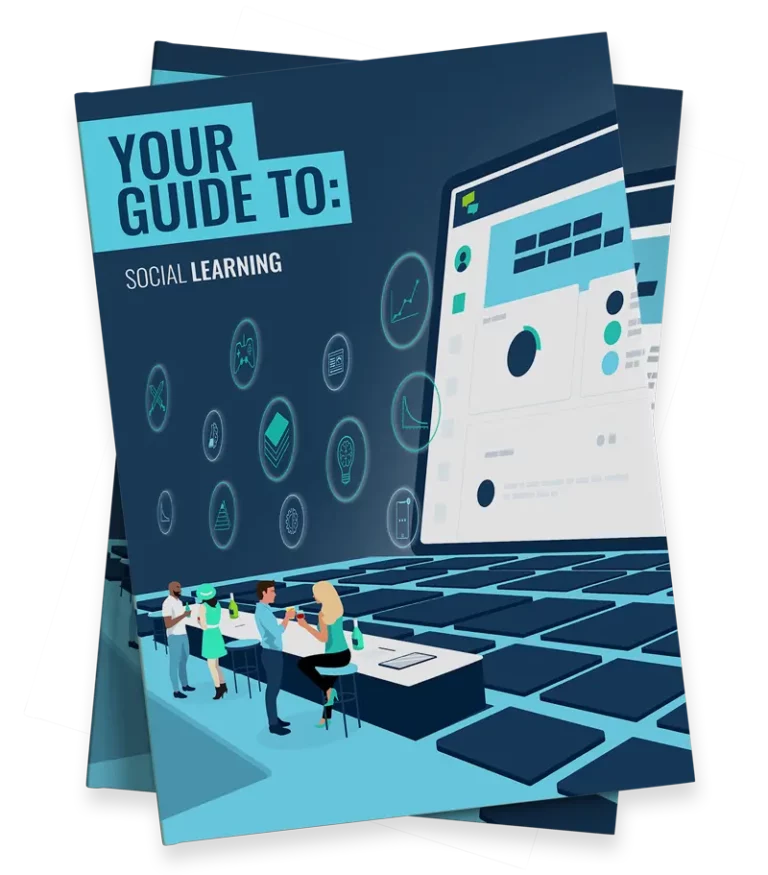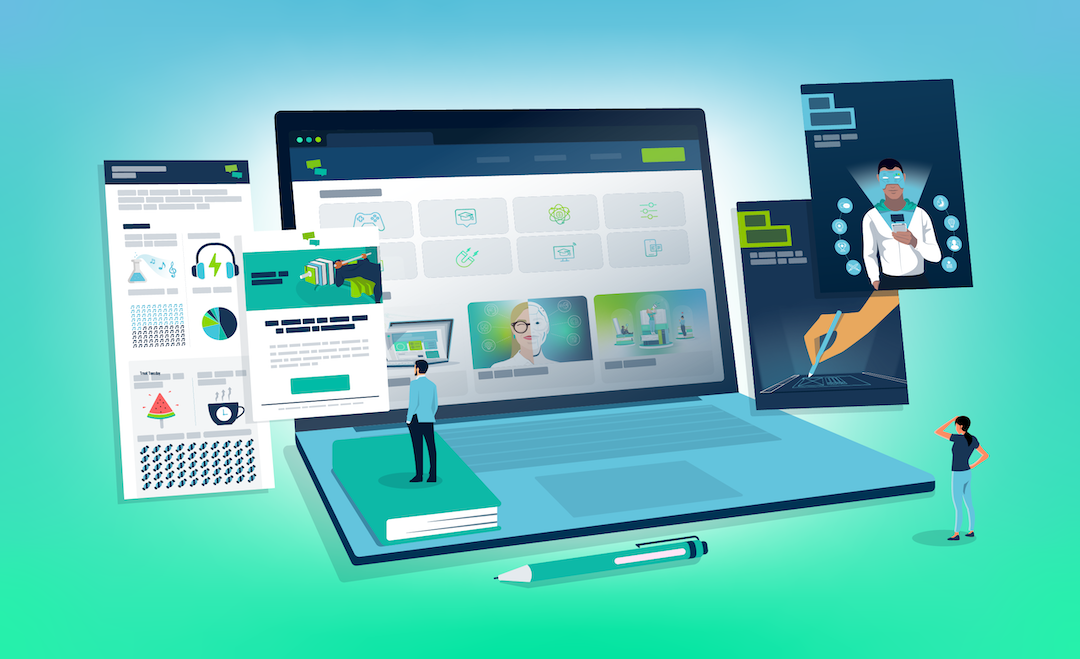
You know that old saying, ‘two heads are better than one”? Well, imagine the power of a whole group of heads! We’re about to tap into that potential with cohort-based learning, an educational approach that blends collaboration with structured teaching to create something truly special.
Cohort-based learning foregrounds human connection while turning up the dial on accountability. It transforms education into a shared experience where you grow, stumble, and succeed alongside your peers.
As Ken Robinson puts it, ‘Most great learning happens in groups. Collaboration is the stuff of growth’.
In this article, we’ll define cohort-based learning, outline its key characteristics, explore its advantages and disadvantages, and then give you some solid tips for building your own programme. Ready? Then let’s cohort up and conquer!
What is Cohort-Based Learning?
If you’re sick of flying solo, cohort-based learning could be just the solution you need. This term was reportedly coined by Gagan Biyani, the CEO of Maven and former president of Udemy. But what exactly does this approach entail?
Well, at its core, cohort-based learning brings together a group of learners (or a ‘cohort’) who progress through a learning experience together and engage in structured activities that are guided by a common schedule.
Think of it as a supercharged study group, where everyone’s working their way through the same learning journey. But, let’s break it down further. Cohort-based learning experiences have the following characteristics:
- Groups: Instead of working in isolation, learning happens as part of a predefined group. This creates opportunities to pool knowledge, share insights, and support each other when necessary.
- Schedule: The learning journey follows a shared timeline, with clear milestones and deadlines that keep everyone moving forward at a similar pace.
- Structure: The learning activities are typically intentionally structured (or ‘scaffolded’) to build upon each other, creating a logical flow of information.
- Interaction: As learners work together in a group, there’s ample opportunity for interaction through discussions, group projects, and peer feedback.
- Guidance: While cohort members learn from each other, the overall experience is typically guided by a knowledgeable instructor or facilitator.
Let’s illustrate this with an analogy. Picture a group of explorers embarking on an expedition to reach a specific summit. This ‘cohort’ starts together, follows a planned route, rests at pre-set milestones, and supports each other throughout any challenges that arise.
Cohort-based learning is similar, except that the ‘summit’ is the learning objective that we’re seeking to achieve. In our case, the expedition leader is the instructor or facilitator who helps to guide us on the way to this goal.
Examples of Cohort-Based Learning

So, where does cohort-based learning really shine? Let’s take a look at some real-world examples to see how this approach is currently being used in different educational and professional settings.
- Onboarding Programmes: As organisations frequently hire in waves, new starters often go through onboarding in cohorts. As a result, the group can learn about company culture and new processes as a team.
- Leadership Programmes: Likewise, cohort-based learning is highly effective for leadership training. After all, it provides a platform for future leaders to learn together and develop a shared understanding of leadership principles.
- Higher Education: Traditional undergraduate and graduate programmes often see groups of students working through the same curriculum, with everyone aiming to finish within a fixed period. Just think of your typical three or four-year bachelor’s programme or an MBA.
- Bootcamps: Intensive programmes focused around specific skills (such as coding or UI/UX design bootcamps) often use cohort-based learning. As a result, students can learn from each other, bounce ideas around, and team up when needed.
- Accelerator Programmes: When a startup is admitted to an accelerator or incubator programme, they typically join a cohort. This group of learners then has access to workshops, mentorship opportunities, and networking events.
Cohort-Based Learning vs. Self-Paced Learning
Another good way to understand cohort-based learning is to contrast it with its polar opposite, self-paced learning. These are two distinct approaches that differ in their structure, pace, and level of interactivity. Here’s the breakdown:
| Characteristic | Cohort-Based Learning | Self-Paced Learning |
|---|---|---|
| Pace | Fixed pace shared with the group. | Flexible pace based on individual progress. |
| Schedule | Predetermined with clear milestones and deadlines. | Adaptable schedule based on individual needs. |
| Structure | Sequential activity structure for the group. | Modular learning assets for learner navigation. |
| Interaction | High interaction with an emphasis on collaboration. | Low interaction with a focus on individual study. |
| Instructor | The instructor guides the group throughout the schedule. | The instructor provides resources and guidance as necessary. |
| Community | Group-based learning with a strong sense of belonging. | Individual learning with optional social interaction. |
| Flexibility | Low flexibility tied to the group’s schedule. | Higher flexibility based on the individual’s needs. |
| Accountability | Peers and schedules drive higher accountability. | Accountability is driven by self-discipline. |
The Benefits of Cohort-Based Learning
So, where has all this buzz around cohort-based learning come from? Well, for a start, it aligns with how we learn best, especially when you consider the popular 70:20:10 framework. This model suggests that we pick up our knowledge from the following sources:
- 70% Experience: Collaborative projects and hands-on activities can be used to inspire learning within a cohort.
- 20% Social: Peer discussions, feedback, and regular group interactions help cohort members to learn from each other.
- 10% Formal: Despite these informal elements, each cohort still follows a structured curriculum and is guided by an instructor.
This helps to explain why 7 in 10 organisations (69%) agree that cohort-based learning is ‘highly’ or ‘moderately’ effective. But what is it that makes it work so well? Let’s now seek to understand the advantages of this learning approach:
- Higher Completion Rates: Shared momentum is a marvellous thing. In fact, cohort-based learning has a miraculous 90% completion rate. On the other hand, only 12.6% of learners make it to the end of a self-paced online course. Clearly, learning together breeds commitment.
- Increased Engagement: Those completion rates point to something else: cohort-based learners are also more engaged. This is partly due to the extra nudge of accountability you get from learning with others. Indeed, 71% of learners agree their cohort motivates them to continue their education.
- Better Retention: Cohort-based learning can also support you in the battle against the dreaded forgetting curve. For example, one study found that active and collaborative learners’ knowledge retention scores were 3.2x better than passive learners (with follow-up test scores falling by 6.5% and 21% respectively).
- Stronger Networks: Participating in a cohort means building real connections and expanding your network. As it happens, 78% of learners agree that being part of a learning community positively influences their educational progress. What’s more, 80% of employees consider networking to be important to career success.
- Improved Outcomes: It’s easy to imagine how all these benefits could translate into real business impact. But, let’s let the studies speak for themselves. They show an 82% positive shift in leadership ability and a 91% boost in skill performance. Additionally, 90% of learners agree that the cohort model drives academic success.
The Limitations of Cohort-Based Learning
Unfortunately, cohort-based learning isn’t a perfect fit for everyone or every context.
In fact, nearly half of Gen Z (43%) claim to prefer a fully self-directed and independent approach to learning. And 72% of learners now spend more time diving into training content they’ve sought out, rather than learning that’s assigned to them. Learning together clearly isn’t a one-size-fits-all solution, so let’s dig into why that is:
- Less Flexible: Cohort-based learning follows a strict timetable with clear milestones and deadlines. This structured approach may be challenging for those who are attempting to juggle work, family, and everything else. It’s notable that 84% of survey responders say they like online learning due to the ‘flexibility’ it offers. And there’s a reason why hybrid learning is so popular. This is clearly an important consideration to keep in mind.
- Less Personalised: In a cohort, each individual is on the same learning pathway. This means there’s little scope for exploration or deviation. And that personal touch really matters. For instance, a metareview of 69 studies found that personalised and adaptive learning led to improved academic performance in 59% of cases and better engagement in 36% of cases.
- Group Dynamics: Learning in a group isn’t always sunshine and rainbows. It can result in dominant personalities who hog all the talking time, participation shirkers, and even interpersonal conflicts. As the saying goes, one bad apple spoils the whole bunch. In fact, studies into the ‘bad apple effect’ show that groups with a negative influence see half the number of top grades compared to smoother groups (10% vs 21.3%).
- Cost Considerations: To make cohort-based learning work, you need a skilled facilitator who can keep everyone engaged and moving forward together. Plus, to get real interaction and teamwork going, you’ll need a physical meeting space. These costs can easily pile up. For example, L’Oréal Travel Retail estimates that they slashed their training costs by 30% just by switching from classroom-based learning to our mobile learning application.
As with any learning approach, there are always tradeoffs to be made. Understanding these limitations allows you to make informed decisions and set realistic expectations when considering or implementing cohort-based learning. This brings us neatly onto our next section.
How to Create a Cohort-Based Learning Programme

A whopping 89% of organisations are planning to use a cohort-based or collaborative learning approach over the next year. If you’re thinking of taking the plunge yourself, then you’re in the right place! Here’s a step-by-step guide for getting started:
- Establish Your Goals: Regardless of your methodology, all good learning programmes require clear goals and objectives. Start by outlining what specific skills, knowledge, or behaviours you want to develop in your employees. Or, put another way, what business problem are you trying to solve?
- Assess Your Resources: With this goal in mind, consider all the resources you’ve got to work with. You’ll need to establish what budget and personnel (facilitators, instructional designers, admins, etc.) are available to you. You should also consider what technology you’ll require — we’ll discuss this in more detail shortly.
- Build Your Curricula: With resources secured, you can now focus on developing your learning curriculum. Design materials that align with your goals and leverage the strengths of cohort-based learning. Prioritise activities that encourage learner collaboration, discussion, and application of knowledge and then build a schedule that works for your audience.
- Form Your Cohorts: Next, you’ll need to set up your cohorts. Group sizes should be big enough to facilitate meaningful interaction and small enough to avoid overwhelming your facilitators. Research suggests that groups of 3-5 learners are best for small group study, while the optimal group size for online collaboration is between 25 and 35. You’ll also need to think about the best way to team people up, perhaps based on location or skill level.
- Launch a Pilot: You’re almost there now! But before you roll out your full programme, think about running a small-scale pilot with a select group of users. This is a great opportunity to test-drive the curriculum, activities, and how your facilitators are guiding the learning. Make sure you’re collecting useful feedback and data along the way.
- Utilise Feedback: Use the learning data and feedback gathered throughout the pilot programme to evaluate its effectiveness against your learning objectives. This should help you to pinpoint what worked well and what could be even better before you launch your cohort-based learning programme to a wider audience.
Using Technology to Support Your Cohort
So far, so good. But, if you want to really supercharge your cohort-based learning approach, you’ll need to embrace the right technology. Here’s how you can use digital tools to connect your learners, streamline the process, and boost engagement.
- Learning Platform: Choose a learning platform (such as a learning management system or LMS) that will support your cohort-based learning programme. You’ll need the ability to deliver content and assessments, scheduling functionality, video conferencing features, progress tracking tools, and more.
- Community: Many LMSs will come with social learning features that you can use to create a sense of community among your cohort. If yours doesn’t, then consider finding an additional tool that can help you with announcements and reminders, while also facilitating direct communication between instructors and learners.
- Engagement: A lot of learning platforms also pack built-in engagement features that you can use to keep your audience hooked. For instance, Growth Engineering LMS uses badges to incentivise activity, levels to showcase progress, and leaderboards to highlight top performers. Don’t forget to acknowledge and celebrate learner progress throughout your programme.
If you’ve followed all these steps, you’ll be the proud owner of a well-structured and engaging cohort-based learning programme that encourages collaboration and enhances your learning outcomes. Just remember that flexibility and a willingness to adapt based on feedback will be crucial for your long-term success.
Final Words
So, there you have it folks! It’s time to forget those lonely learning tumbleweeds rolling through your organisation. Cohort-based learning is here to help us connect, collaborate, and conquer learning goals together.
While this approach can be challenging to set up (and costly to maintain), the payoff for both you and your learners can be huge. The significantly higher completion rates alone make it a seriously compelling option for tackling your organisation’s most critical learning needs.
Why not give it a shot? It’s time to get your cohorts connected and watch the learning magic happen.
Thanks for reading! If you’ve enjoyed this content, please connect with me here or find more articles here.
And for even more practical guidance on leveraging social learning principles, check out ‘Your Social Learning Guidebook’. It’s packed with actionable tips to help you build the learning community of your dreams!









